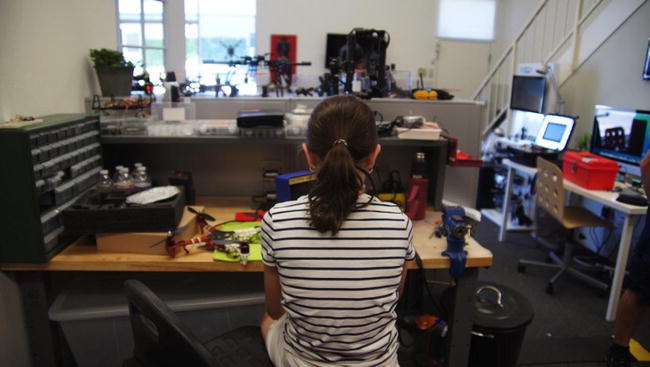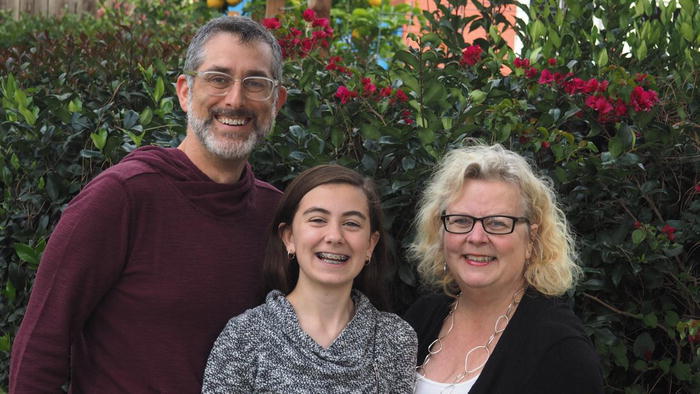Foreword
By Coco, Mosa, and Nancy Kaleel
When our daughter Coco was very young, she wanted to play with robots and servos and soldering. We were lost. As filmmakers and writers with backgrounds in animation and romantic comedy, we understood her creative desire but immediately became intimidated by the complex terminology and technology that she wanted to learn. We needed subtitles to help us understand and guide her into this amazing world of makers and truly innovative people.
This book was written for parents like us, teachers, and others.
But first, let’s start with Coco’s story from her (currently) 13-year-old point of view.
The Maker
My maker story started one sunny morning when I, a preschooler in pink footie pajamas, was playing with my Tinkertoys. My parents were preoccupied with painting a room, so they couldn’t be disturbed. A very ambitious child, I was trying to make a carousel for my stuffed animals, but I didn’t want to push it with my hand. Frustrated, I asked my dad for help. He told me I’d have to wait because he was covered in paint, so I went back and figured it out myself. An hour later, I had built a crankshaft-equipped “carousel” above a “toy store.” In the end, the carousel didn’t seat any stuffed animals (it only turned), and the toy store was just an empty wireframe of a cube, but we had all learned a very important lesson—I was a maker.
I was the kid who went as an astronaut on Halloween and got LEGOs instead of dolls for her birthday. The Christmas of my 9th birthday was my first introduction to LEGO Mindstorms, a version of a robotics kit equipped with a basic programming environment. A few months later, I informed my bewildered dad that I wanted something more complicated. Shortly thereafter, my father took me on my first trip to a robotics club, where I eventually learned to solder and program Arduinos.
This is where my story took a turn. I got a 3D printer kit, and I taught a soldering class at the Los Angeles Public Library. I started a website (www.veryhappyrobot.com) to inspire others and share my experiences. I was invited to present at my first conference, where I gave a speech called “Girls and Robots.” Joan Horvath, one of the authors of this book, invited me to give a poster presentation at the 3D Printing World Expo. I also spoke at the Texas Linux Festival, all with the goal of inspiring kids to learn technology. Currently, I co-chair a 3D-printing club at my school. We are working to design 3D objects that will help blind kids learn math, a challenge presented to us by Joan.
Having this book five years ago, when I told my parents I wanted more, or ten years ago, when I had just finished my “carousel,” would have been a big help to all of us. There was no beaten path for them to take. When they discovered the robotics club or when I built that printer from a kit (I am still the youngest person to ever assemble it), they knew they had found something special for me.
Luckily, the amount of resources for maker kids has increased. Toy manufacturers have created building kits for girls and boys. People and groups and companies are creating things all the time and often give away their “secrets” in the name of open source, so I, or anyone, can take it and make it work for me. And if I ever get stuck on something, I am not afraid because I know there will be someone who got stuck the same way and will help me get unstuck. And someday, I’ll help the next kid get unstuck.
I also look forward to the day when shop classes come back, and technology is a key focus in learning, and there is a 3D printer in every school, and C++ is taught just like a foreign language. Developments like these will inspire my generation and all the generations to come and show that makers and programmers aren’t scary beings that can hack into your phone from a mile away. Makers are problem-solvers, thinkers, and bi-linguists. You can see me being one in Figure F-1.

Figure F-1 Coco at work. Photo courtesy of Mosa Kaleel.
The Parents’ Perspective
If a child has an early proclivity for sports, music, or leadership, parents can easily find T-ball or American Youth Soccer Organization (AYSO) teams at the local park for their young athletes. Music teachers, choirs, drama and dance academies, and youth orchestras abound for kids passionate about the performing arts. There’s scouting for kids with community interests.
But what about the kid who wants to build robots, program, solder a circuit board, or take everything apart to just see how it works? Oh, how we wish there were peewee leagues for science, technology, engineering, and math (STEM) when Coco was in preschool. Or maybe you’re a teacher or an artist or an interested adult? There is often nothing available to kindly guide and inform you through this daunting process.
The Next Thing?
After the Tinkertoys, LEGOs, and Mindstorms, we were clueless about “the next thing” for our daughter. It seemed so simple to her that there would be something else, but we had no idea what, or whom to ask. All we could say to anyone was that our daughter wanted to code (okay…), to take everything apart (as evidenced by our insistence that, moving forward, the TV remote is used to change the channel only), and to make robots (who wouldn’t want that?).
Unfortunately, her elementary school could offer no support. There was no space in the curriculum, no physical space on campus and no money in the budget to explore technology. Worst of all, despite a lot of teacher curiosity none of the teachers really understood the technology. If we’d been scientists or engineers ourselves, things might have been different.
Although we were able to learn a lot piecemeal on the Internet, we craved a centralized authority to guide us when it came to making. Then we found out about hackerspaces and robotics clubs that were close to our house. These places are explored by Joan and Rich in Chapter 5.
By happenstance, a lecture promoted by a local robotics group about Raspberry Pi (see Chapter 2) was being held at a local hackerspace. When Coco first set eyes on the venue for the presentation and met the membership of that group—all adults—she immediately said, “My people!” They seemed to see a bit of themselves in Coco, too, and eagerly helped start to teach her what we couldn’t. We can’t thank all of the people that we met there enough.
The robotics group counted aerospace engineers and graduate students among its membership. Coco learned about the Arduino, the basics of electronics, and how to solder alongside many adults. She discovered she was quite good at it (that fearlessness of a then ten-year old). Ask someone over 55 about soldering, and they’ll tell you the projects they made as a kid in shop class in school. Ask someone under 21, and most don’t even know what soldering is.
Creating a Maker
One thing we did realize along the way was that although there is a lot of ready-made equipment out there, a great way to learn something is to make or assemble it yourself. We found that kits were perfect for Coco. This was especially true of the 3D printer. We knew that consumer 3D printers were in their infancy and that Coco would have to fix it if it broke because, in case it’s not obvious yet, her parents would be useless. She loved kits and started a website to help people get started and to chronicle her journey.
We decided to invest in a 3D printer, and Coco assembled it herself as a kit (at age 11). Not only did she learn about the engineering, software, and mechanics, she also met Joan and Rich in the process. Their knowledge base, from both traditional and new perspectives, as well as their amazing willingness to openly share was a turning point for Coco. They set the stage for Coco to start to put together the various aspects of technology that she had been learning.
Coco got very comfortable printing and making things. She then wanted to learn about quadcopters, so she built a kit. The owners of a (rare) brick-and-morter drone store near our house encouraged our daughter to learn about drone technology. When Coco noticed that the camera mount on her drone didn’t fit properly, they encouraged her to find a solution. As an eager 12-year old, she learned a 3D-modeling software, used it to design a proper camera mount, and printed it on her 3D printer. It took a bunch of tries, but eventually she got there, along the way learning one of the most valuable lessons a child could learn—perseverance. She then uploaded the design to a sharing website where it’s since been downloaded several hundred times. You can see the three of us taking a break from all that in Figure F-2.

Figure F-2 The Kaleel family. Photo courtesy of Mosa Kaleel.
Your Turn
Coco’s camera mount, a small simple piece of plastic, brought together the cumulative efforts of soldering, electronics, 3D printing, and sharing. Joan, Rich, and a community of engineers and makers pushed a 12-year old to problem-solve and learn far beyond what we could have imagined for her. But not everyone can be so lucky to have mentors and experts in robotics, 3D printing, and drones all in the same community. Joan and Rich recognized this and decided to provide you with this resource by filling in the gaps and connecting the dots that took us years to find and understand.
Our hope for the future is that schools and communities will build the same support systems and infrastructure for kids who love robotics, programming, and 3D printing just as they’ve done for baseball, soccer, music, dance, drama, and scouting. We can look at all the advantages that athletics, the arts, and community service do to enhance a child’s life experience. We look forward to the day when technology will be assimilated in the school curriculum and at community centers to benefit the makers and innovators of tomorrow.
We wish that Joan and Rich’s book had been available to us ten years ago when we first discovered Coco’s desire to be a maker. We didn’t even have a name for it back then—we just knew she loved to build, tinker, and discover what made things work. Even a decade later, the infrastructure to support kids with this passion is just now getting started. This book is an excellent resource to ensure that a young child’s inclination for technology, engineering, and making is fostered and fully realized.
